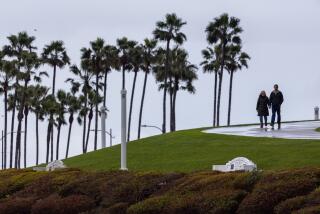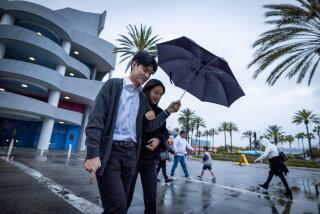Southern California girds for more rain — and damage
Cities and counties throughout Southern California are bracing for more wet weather and additional damage as a new storm system is expected to hit the region this week.
Heavy rain on Christmas night further slowed cleanup of last week’s damage and preparation for additional precipitation, officials said.
Highway 330 to Big Bear may remain closed through the winter since portions of the road crumbled after being undermined by rain, said Caltrans spokeswoman Shelli Lombardo.
“If you look up to the side” of the mountain, she said, “the slope slid, and as a result of that, the road buckled. This has happened on the mountain before, and we’ve had to wait all winter till the mountain dried out and we could fix the road.”
Officials rerouted motorists traveling to Big Bear onto State Route 38 through Redlands. Highway 18 has also been closed since last week, but that road may reopen sooner because damage was not as severe as officials initially thought, Lombardo said.
In Orange County, a portion of the 241 Toll Road near Santiago Canyon Road will remain closed through Wednesday because of extensive mudslide damage.
Farther south, transportation officials reopened the 133 Toll Road for motorists traveling toward Foothill Ranch, Lake Forest and Rancho Santa Margarita via the 241.
Authorities in flood-ravaged Highland in San Bernardino County cleared 50,000 cubic yards of debris from catch basins and placed more than 100,000 sandbags throughout the city. They’ve also added K-rails to divert mud away from homes.
“The hillsides are still very, very wet, and with more rain coming we’re preparing for the worst and hoping for the best,” said Bill Peters, a spokesman for the California Department of Forestry and Fire Protection.
Five residences were destroyed and 73 damaged last week by mudflows. Fire officials said 30 homes remain threatened, and mandatory evacuations were still in effect Monday evening.
Elsewhere, AT&T spokeswoman Debbie Rapoport said landline outages were reported throughout the greater Los Angeles area and crews were brought in from Northern California to bring customers back online.
“We’re working ‘round the clock. Any time there’s rain — especially when we’re already restoring service — doesn’t help,” Rapoport said.
As of Monday, 9.42 inches of rain had fallen in downtown Los Angeles this December. That’s good for second place in the city’s recorded weather history, which dates from 1878.
“There’s more rain coming Wednesday, so we’ll probably be going over 10 inches,” said Bill Patzert, a climatologist for the Jet Propulsion Laboratory in La Cañada Flintridge.
“It’s not 15.8” inches, the record set in 1889, “but it’s not chicken liver either,” Patzert said.
This year’s totals for downtown are based on a rain gauge at USC, which some scientists say records lower totals than the old station at the Civic Center.
That station, which is still maintained by Daniel Resch, a hydrologist with the Department of Water and Power, has documented 10.88 inches of rain downtown this month.
The precipitation may not be done with L.A. this year, but Patzert said that regardless of which weather station is used, the 19th century December rainfall record is probably safe. The 1889-90 rain year was one of the wettest in history.
But whether January, February and March will turn out to be rainy affairs remains to be seen, Patzert said.
“The big question is, do we end up like January, February and March of 1890 and get really wet? Or do we go dry?” he said. “Is a wet December a good predictor of a wet winter? The fact is, we don’t know what this says about the coming months.”
More to Read
Sign up for Essential California
The most important California stories and recommendations in your inbox every morning.
You may occasionally receive promotional content from the Los Angeles Times.











